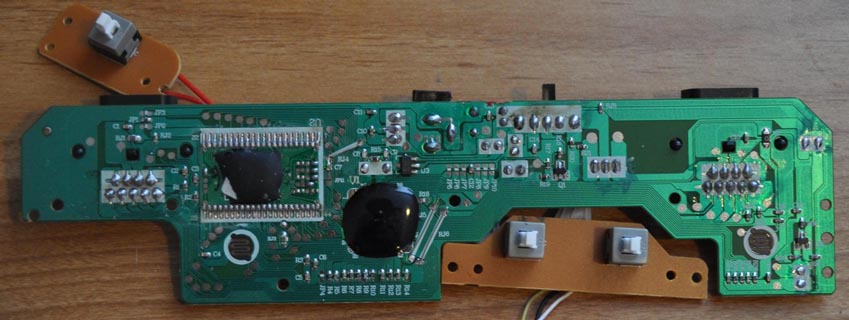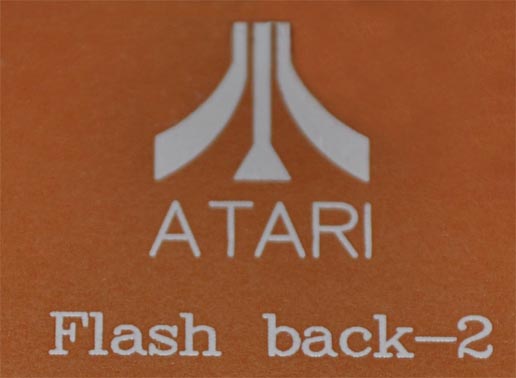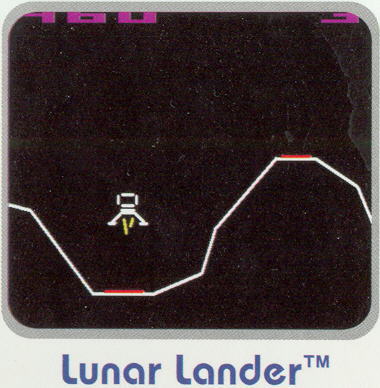

Atari's Flashback 2.0 Takes Flak (and deservedly so)
What should have originally been done with the first Flashback system was what's been done with every version since #3 - make it emulator-based. Flush with some 22 million in sales from the Flashback (i.e. suckering a half-million people to buy it), Atari decided to push ahead with its plans to release another model, the Flashback 2.0 (or Flashback2 as it was later called), and contracted out to the same person to design it as well. Here is their official announcement, dated April 27th, 2005, which sounds very similar (i.e. more promises):
| Atari(R) Flashback 2.0' Announced - Plug-and-Play Console Celebrates 30th Anniversary of Pong(R) - NEW YORK, April 27 /PRNewswire-FirstCall/ -- In response to consumer and retailer demands, Atari, Inc. (Nasdaq: ATAR) today announced the summer launch of Atari(R) Flashback 2.0, the follow-up to the holiday 2004 hit, the Atari(R) Flashback Classic Game Console, which shipped more than 550,000 units to retail. Atari Flashback 2.0 will be modeled after the pioneering Atari 2600 console and heralds in the 30th anniversary of Pong(R), the first arcade game created for the home which started the revolution that has today turned into a $10 billion industry. The Atari Flashback 2.0 will feature Pong as well as 40 other classic games including Asteroids(R), Centipede(R), Millipede(R), Lunar Lander(TM), Breakout(R), Missile Command(R), Combat(TM) as well as retro game and arcade classics that have never before been released for the home console. Atari Flashback 2.0 will feature the same wood grain paneling and look of the Atari 2600, and will capture the feel through two classic joysticks for multi-player competition and vintage controls. "The Atari Flashback series harkens back to the early days of video games where the simplicity of design and the addictive game mechanics connected instantly with audiences of all ages. Even in this day of advanced and more complex gameplay, these legacy games continue to elicit fantastic reactions via the on-screen action, and again, to a wide and broad audience," said Wim Stocks, Executive Vice President, Sales, Marketing, Licensing and Distribution. "Now, on the 30th anniversary of Pong -- the grandfather of all video games -- it is fitting that we begin to commemorate this milestone with the launch of Atari Flashback 2.0." The Atari Flashback 2.0 promises to deliver the same gaming sights, sounds and action as the original Atari 2600. To ensure this authenticity, Atari has engineered the tools and code of the original games for reproduction on modern chip technology. "Unlike other nostalgia gaming products on the market, the Atari Flashback is the real McCoy and the games included are originals, not third-party ports," said Curt Vendel, president of the Atari Historical Society and contributing producer for Atari Flashback 2.0. "Atari has traveled back in time to recall an era where the experience was paramount to the technological bells and whistles." Developed by Atari, the Atari Flashback 2.0 will be available early this summer for under $30 at retailers nationwide. |
I'm not sure how this new Flashback model "heralds in the 30th anniversary of Pong" when Pong was 1) released in 1972, and 2) never released separately for the VCS, but only as a variation on Video Olympics. When questioned about it, Goldberg stated it was the home version of Pong that was being referenced, which was "responsible for jumpstarting and creating the console market". How exactly a product can both create a market AND jumpstart a market that presumably didn't exist, I don't know, but Atari's home Pong system was hardly the first home console, so it certainly didn't create the console market. It did however drive up sales for itself and all the systems currently in the market at the time, and helped motivate other competitors to enter the market. Instead of celebrating the home version of an arcade game, why not, oh I don't know, celebrate the anniversary of the VCS - the system whose coattails this new Flashback system is clearly riding on? But Goldberg has a history of twisting facts around to fit his narrative. It's also interesting to note that Vendel is not stated to be the engineer or designer for this but rather a contributing producer, because that's really all he really is with any of his projects.
In an effort to make amends for their 'Flashback Folly', the 2nd version now resembled a VCS/2600 system (albeit much smaller) and featured twice as many games, with all of them being the original code (no ports). The system's buttons are similar to the round, 'candy-like' buttons found on the Atari XEGS system, and not the brushed aluminum toggle switches found on the original VCS. But it's a step in the right direction. The 5 buttons are for Power, Select, Reset, and both the Left and Right Difficulty. A cheap sticker with the Hasbro-style Atari logo is on the control panel. The bottom features a raised logo molded into the plastic.
The games are now running on a custom chip that attempts to replicate the VCS's custom TIA chip. According to Curt Vendel's mouthpiece, Martin Goldberg,
| "This Flashback 2.0 is running on an actual 2600-on-a-chip. That's right, no emulation, no ported games. Care was taken to reproduce the entire 2600 hardware in a single chip format (last attempted towards the end of the 2600jr's lifespan). Because of that, the ASIC-based reproduction of the 2600's hardware is flawless in it's execution of original 2600 code." |
I say "attempted" because it failed to, as I will mention later on.
The controllers resemble the original standard joysticks and are the same size, but in this case, looks can be deceiving. Remakes usually involve an attempt to correct previous flaws and weak points - not a chance to introduce new ones. While the switch contacts are an improvement, the stick itself is made to be detached (unscrewed) from the rest of the controller, as if they wanted players to lose or break them. Not only that, the stick itself is comprised of 2 pieces (it can be separated from the part the screws into the base of the controller) and if you lose either part, you'll need another controller because there's no replacement parts. Even worse, guess where these sticks typically break? That's right. If the top of the stick doesn't detach from either the part that screws in, or the base of the controller, it will (very) likely break off at the base (and you're "screwed"). Since its release in 2005, a great many gamers have reported them breaking at the controller's "Achilles' heel". This is what happens when non-gamers try to design products for gamers. However, the controller's flaws aren't the only ones.
The 40 games are selected from a series of menus and sub-menus - all of which are pretty bland. But Goldberg sung its praises, stating Vendel put a lot of time and effort into designing a "wonderful menu system that gives a great experience". Let's look at these wonderful menus that took so much time and effort of someone's life to make:
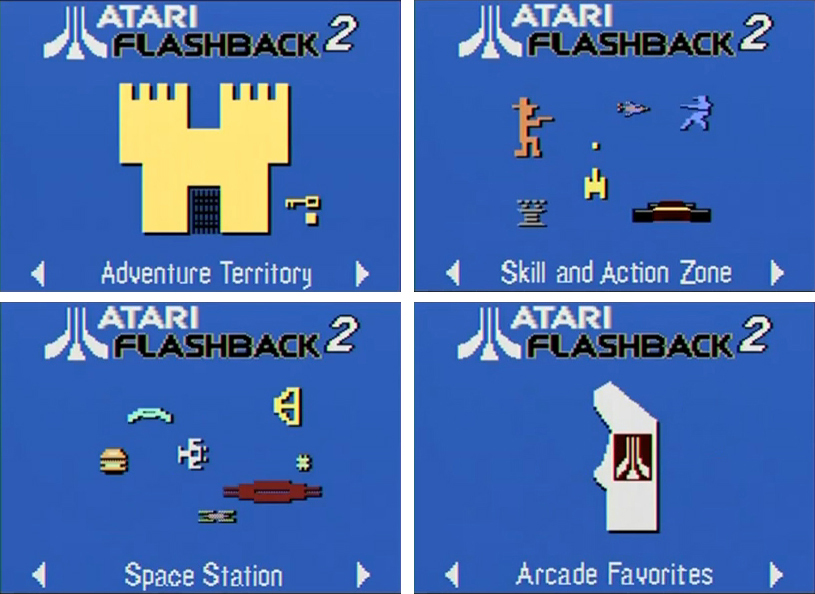
Wow. That's a lot of copying-and-pasting of images onto a blue screen. Someone might have spent a whole HOUR putting that together! Well, I guess we now know who didn't design the menus for the first Flashback...
Damn, that's some pretty unimaginative stuff right there, but then again, compared to the menu on the Flashback2 prototype, I suppose anything would have been an improvement. The 4 categories are supposed to be similar to those in the original Atari catalogs (Combat Zone, Sports Arena, Classics Corner, Adventure Territory, Skill Gallery). Instead of a Racing section, there's "Arcade Favorites" - most of which are the new arcade hacks and homebrews. Maybe that was an intentional nod as to how out-of-touch Atari's Marketing department was at times, back in the VCS's heyday?
As you can see from the list of games below (titles spelled as shown onscreen, with typos, capitalization, and punctuation mistakes), not all the games are original classics as promised ("The games included are originals, not third-party ports."), as you'll notice almost half of them are hacks and homebrews. Also note Battlezone isn't alphabetized in its category like every other game but instead at the bottom of the list, as though it was added at the last minute:
| 3D Tic Tac Toe Adventure Adventure II (hack of Adventure) Aquaventure (unreleased prototype) Asteroids Asteroids Deluxe (hack of Asteroids) Atari Climber (homebrew) Battlezone Caverns of Mars (homebrew) Centipede Combat Combat 2 (unreleased prototype) Dodge'm Fatal Run Frog Pond (unreleased prototype) Hangman Haunted House Human Cannonball Lunar Lander (homebrew) Maze Craze Millipede |
Missile Command Off The Wall Outlaw Pitfall! (Activision title) Pong (homebrew) Quadrun Radar Lock Return to Haunted House (hack of Adventure) River Raid (Activision title) Saboteur (unreleased prototype) Save Mary (unreleased prototype) Secret Quest Space Duel (hack of Asteroids) Space War Super Breakout (hidden bonus game) Video Checkers Video Chess Warlords (hidden bonus game) Wizard (unreleased prototype) Yars' Return (hack of Yars' Revenge) Yars' Revenge |
The whole list is so hit and (mostly) miss. First off, the hacks should never have been included, especially since the original games are included as well! Centipede and Millipede are great games, but why do we need both here? There was quite the screw-up with Millipede, as the unreleased GCC version was featured on the box, and some variations either having the Atari version or the GCC version (LINK). And why are 3rd-party games on this? Activision had already licensed their games out for TV plug-and-play systems by Jakks by now. At most there's 34 *different* games (36 if you count the 2 bonus hidden games, which most owners probably never saw). Including games primarily designed for 2-players (Combat Two, Frog Pond, Space War) doesn't make much sense, and neither do questionable entries like Hangman, Human Cannonball (which was a running joke amongst my friends back then), Space War, and Wizard, being there was a limit of only 40 games. I suppose an argument can be made as to why games like 3-D Tic-Tac-Toe and Video Checkers are included, but I personally don't remember playing them very much (and Video Chess runs so slowly, nobody would waste time playing it these days). Common sense would have removed the homebrews and hacks, and included more original games like:
Air-Sea Battle
Basketball
Canyon Bomber
Circus Atari
Crystal Castles
Desert Falcon
Gravitar
Night Driver
Sky Diver
Solaris
Sprint Master
Stunt Cycle
Submarine Commander
Super Breakout
Surround
Video Olympics
And yet, one of the VCS's most-popular titles, and its first "killer app" - Space Invaders - is nowhere to be found. How many revamped versions of Space Invaders have we seen over the years (for nearly every system out there)? I doubt anyone at Atari even bothered to try and get the rights to include it. Same for Pac-Man, the biggest-selling VCS game of all time. As bad as Pac-Man is, I'd still want to see it included; as much as I like games like Star Ship and Slot Racers, I'd be shocked if they were included, because they had a niche following. The excuse was Atari didn't want to pay to license anyone else's games (and yet Pitfall! and River Raid are included...), plus it would drive up the price to $70, and:
| "No way in hell would anything like that fly in a plug and play. A $70 price point for a collection of games that modern gamers wouldn't cast a second glance at? What are you smoking? There's a reason why there's a $30 price point on these, and there's no way any actual game company would see any validity in what you're stating. The value is just not there, you'd get laughed out of the board room trying to present it." |
As for the unreleased prototypes, there's a reason such games went unreleased or unfinished - they weren't fun to play. If I had only 40 titles to choose from, I can think of a LOT more worthwhile games to include that your average consumer likely would be familiar with, and not fillers like Wizard or Human Cannonball. The homebrews Caverns of Mars and Lunar Lander are just atrocious, and the 5 hacked games aren't much better, with one (Yars' Return) being so bad, it elicited this response from Howard Scott Warshaw, the creator of Yars' Revenge:
| "This (Yars' Return) so lacks creativity that (those responsible) could only use the same graphics and color scheme? Jesus! This looks pretty absurd. I do have a design for another Yars, but it is an innovation and has nothing to do with what is being portrayed here." |
For years HSW has publicly stated many times that he's always had an idea on how to do a sequel to Yars. Here's an idea- if you want to do one that badly, and for a product like this, why not ASK the guy who created it? Instead, it's yet another wasted opportunity.
I don't have a problem with homebrew titles, but considering your average buyer isn't going to recognize any of them, 1 or 2 would have been plenty here. I just can't understand that out of all the great homebrews out there (and there's plenty), the only known/credible title included was Atari Climber, an updated version of Dennis Debro's Climber 5 game from the year before. It's actually a port of an Atari 8-bit computer game written by James Rogers that appeared in the August 1987 issue of COMPUTE! magazine (a copy of the game can also be found on Atarimania). The VCS version was done by Dennis Debro and made available in May 2003; it was previously included on the 2003 Activision Anthology and Remix packages and sold in cartridge form in 2004.
Why not release the new hacks and homebrews online beforehand and let the community of dedicated players still out there test them, offer suggestions for improvements, etc. - take advantage of all that invaluable experience! Talk about an untapped resource. What a waste. Same with the hacks, but IMO hacks have no place on a product like this. Again, there's plenty of quality hacks out there, but they choose to go with a bunch of unknown/untested ones. If it contained a lot more games, then fine- sprinkle a few in. That's not the case here, so again with only 40 titles to choose from, even 1 would have been 1 too many. When you factor in what games are fun to play, maybe half the games on this list will see repeat play by owners. The ROMs for all the new games can be found HERE, so feel free to check them out for yourself.
The system was designed to be modified by adding a cartridge port (to play the games that should have been included), but should you take advantage of this, be warned that the "flawless" 2600-on-a-chip is anything but, as evident by the information in my article about it. It seems production problems with the chip resulted in Atari having to release at least 4 different (internal) versions in order to try and fix everything. Goldberg claimed the compatibility issues were fixed with both the final FB2 version, and later with the FB 2+ (they weren't) and felt all the different versions somehow made them collectible! Besides, the chip flaws are the manufacturer's fault, not theirs, just as the manual errors are the printer's fault, not theirs. The fact that nobody did any serious play-testing for this, or that some serious Q/A issues existed in these areas aren't their fault, either. Apparently, nothing is their fault (just like nobody on the Titanic's crew was deemed responsible...). Years later Vendel admitted the system is flawed, but felt that it was okay because it played more than the 40 built-in games and that's all Atari cared about... except, it couldn't even run 1/4th of those correctly! And if that was Atari's intention, why on Earth did Atari bother paying for a custom 2600-on-a-chip for 40 games? The end result is customers again have a system not designed for VCS fans, being sold by a company willing to dump flawed product onto the market. Unfortunately this would not be the end of it, for the same people responsible for the first 2 Flashbacks had one more variation to dump on us 5 years later.
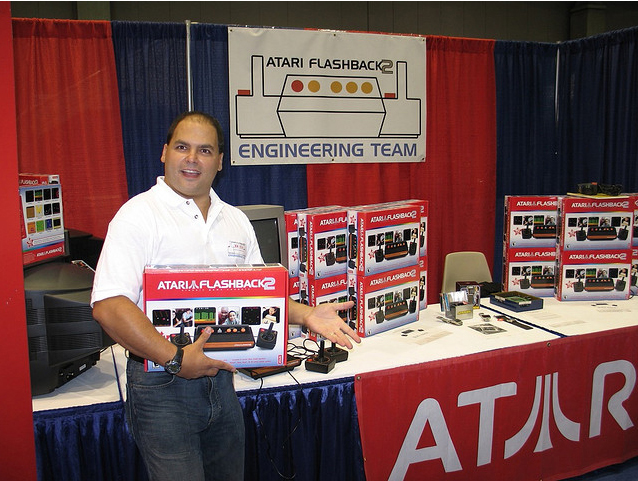
Here's the "team" responsible for the early Flashback failures.
Now for the nitty (and mostly) gritty details:
Hidden games: At the main menu, move the joystick in the following directions: UP 1x, DOWN 9x, UP 7x, DOWN 2x. If done correctly, a secret menu containing 2 hidden games will appear - Super Breakout and Warlords.
Hidden joystick menu: Hold SELECT and RESET with the TV TYPE switch to COLOR and turn the system on.
Hidden paddle menu: Hold SELECT and RESET with the TV TYPE switch to B&W and turn the system on.
A few prototype/demo versions exist that contain only 10 games and a simple text menu, and supposedly don't have all the hardware problems that versions #1-#3 have. However, they don't have a TV TYPE switch.
At least 4 versions of the internal software exist. Note that there is no way to tell which version you have (by the box) w/o either playing it or opening up the case:
Version 1 - has Atari's version of Millipede, instead of GCC's (as indicated on the packaging).
Version 2 - has GCC's Millipede
Version 3 - has Atari's Millipede and corrects the TIA/sound problem- the result of a redesigned pcb ("Rev B"). It also has a version of Adventure II with brighter colors. Video output quality isn't as good when using carts.
Version 4
- supposedly fixes all the incompatibility issues with running certain carts (on a modified system) - the result of another redesigned pcb ("Rev C"). The games are the same as Ver. #3.
At least 4 different hardware revisions exist:
Version 1 - The largest pcb of all 4 versions, with a
"hole" in the center for the power and reset buttons (picture #1).
Version 2 - A redesigned smaller pcb ("Rev B") without the
"hole" (picture #2).
Version 3 - Slightly redesigned ("Rev B") pcb with the game rom (epoxy blob) chip directly on the pcb (picture #3).
Version 4 - Supposedly is a micro pcb ("Rev C") with all the cart mod points in the upper-left corner.
The chip corrected some Hmove incompatibility issues, but still lacked several
65xx Illegal OpCodes and support for FE bankswitching. Only 60k were produced.
Unauthorized Flashback 2.0 systems have a pcb that's similar to the "Rev B" one, but not the same (pictures #4 and #5). They can also easily be identified by the strange Atari logo printed on the board, which is the same logo that appears on the menu (picture #6). The unit's counterfeit PC board lacked stenciling on the solder pads to identify where to connect a cartridge modification. There's also apparently more issues with the built-in games, with some or all of them only appearing in black-and-white.
Two homebrew programmers were commissioned shortly after the FB2's release to correct flaws in some of the new games: Dennis Debro worked on the flicker problem in Yars' Return (and planned to work on Asteroids Deluxe and Space Duel), and Johnny Champeau fixed the bug in Pong and programmed all-new versions of Caverns of Mars and Lunar Lander. Unfortunately, none of these improved versions were ever used in the subsequent releases. A hack of Pole Position (as Checkered Flag) was also unused.
The version of Quadrun (that's on all versions) is actually a pre-release version (dated 3-18-83) - after clearing the first 5 waves, the text "Crazed Wave" should appear (as stated in the manual); instead, "Woita Wave" appears, which was an Easter egg hidden in the release version.
The version of Fatal Run is actually either a prototype or an unauthorized PAL conversion; an NTSC version was never released.
The version of Frog Pong is actually an earlier version; a later version exists, complete with a finished title screen (see the review for it HERE).
5 of the games included are hacks of original titles: Adventure II and Return to Haunted House (Adventure), Arcade Asteroids and Space Duel (Asteroids) and Yars' Return (Yars' Revenge). Also, 2 of the games included are Activision titles (Pitfall and River Raid).
The controller jacks are slightly larger than the originals, which may lead to connection problems. They're also mounted upside-down, compared to a real VCS system.
It's impossible to tell how the difficulty switches are set. Then again, the manual makes no mention of how to use them with any of the games.
The FB2's 2600-on-a-chip software was originally written in VHDL by Carlos Lopez in 2002-2003, who possibly worked out an agreement with Legacy Engineering Group for the rights to use it (and if so, likely signed an NDA about it):
https://forums.atariage.com/topic/15156-jakks-pacific-atari-10-in-1-game-system-review/?do=findComment&comment=151817 - Vendel mentions on October 17th, 2002 that "there is a hobbyist out there right now making a 2600 on a chip".
http://www.biglist.com/lists/stella/archives/200309/msg00238.html - Lopez finished his program in fall 2003 and...
http://www.biglist.com/cgi-bin/wilma/wilma_hiliter/stella/200309/msg00246.html - was in negotiations for its use in a com.product
http://www.biglist.com/lists/stella/archives/200208/msg00156.html - Vendel sent Lopez the TIA schematics to use in writing it
http://www.biglist.com/lists/stella/archives/200208/msg00240.html - Lopez's emulator has a problem with Cosmic Ark
https://forums.atariage.com/topic/75267-fb2-compatiblity-list/ - FB2 has the exact same problem with Cosmic Ark
Vendel later threatened to kick Lopez "in the balls" for questioning his handling of the FB2. Lopez also confirmed he did not purchase but instead was given a set of TIA schematics from Vendel.
Given Vendel's past feloneous history, not to mention his track record of sabotaging shows, forging emails, and erasing posts, anything he stated as "fact" should be questioned. It's unclear whether or not he even held an actual engineering degree. All my research ever discovered is that he worked from home under the company names Westchester Technolgies and Computer Networks of NY doing computer cabling, which of course makes sense because who's going to hire an ex-felon?
BUG: The 5v regulator is always connected; the power switch is actually on the 5v line. Also, there's no heat sink for the regulator.
BUG: A few of the early (version 1) releases went out with a corrupted ROM. Selecting some of the games may bring up different ones, or they may not work at all (solid black or blue screen). BUG: HMOVE lines - there's a design flaw in how the 2600-on-a-chip processor affects later games that take advantage of HMOVE programming tricks, such as Missile Command. The HMOVE problem is more noticeable in other games if the system is modified to use a cartridge port.
BUG: OPcodes - at least 2 opcodes are known to not be supported by the FB2's TIA chip: SBX and ARR.
BUG: Sound - there's a design flaw in the fake TIA circuitry that affects the sound in a number of games. The Atari version of Millipede is missing the marching' sound, the voice in Quadrun is missing, the robbers in Maze Craze don't make any sounds, etc.
BUG: Sync - sync problems plague a number of games, such as Arcade Asteroids, Asteroids Deluxe, Battlezone, Caverns of Mars, Millipede (GCC version, which has too many scan lines for most NTSC sets - enough to be considered a PAL game), Space War, and Yars' Return, making them unplayable. Owner's of TVs with vertical hold adjustments may be able to compensate for this.
BUG: Flickering - the heavy flickering in the new title hacks is a result of poor programming; with the original titles, it's a result of the system's flawed processor.
BUG: Game incompatibility - A number of carts have shown to be incompatible to some degree with one or more system versions modified to have a cartridge port. Most of the following games either use extra RAM, FE bank-switching, keyboard controllers (which aren't supported - they require 5v and the controller ports only output 3.5v. Vendel actually mentioned you could hack your keyboard controller with some resistors to make it compatible!), or depend on special TIA programming tricks:
Airlock (picture rolls)
Alpha Beam with Ernie (requires Kid's Controller)
Astroblast (slight graphics problem)
BASIC Programming (requires Keyboard Controller)
Bermuda Triangle (ghosted player object on right side)
Berzerk (doesn't run on some versions)
Berzerk VE (no voice)
Blue-Print (doesn't run)
Boxing (doesn't run)
Brain Games (requires Keyboard Controller)
Checkers (Activision) (doesn't run)
Codebreaker (requires Keyboard Controller)
Conquest of Mars (severe issues)
Cookie Monster Munch (requires Kid's Controller)
Cosmic Ark (problem with starfield)
Cracked (title screen is a little garbled - crashes when you start game)
Crazy Climber (dotted lines on all the lower the window sills)
Crystal Castles (some gems never disappear allowing you to rack up thousands of points in seconds)
Cuttle Cart (doesn't run)
Dark Chambers (doesn't run)
Decathlon (doesn't run)
Desert Falcon (ghosting problems)
Dig Dug (garbled graphics)
Elevator Action (crashes when you start game)
Fatal Run (crashes after a few seconds)
Galaxian (extra Galaxians; collision-detection with shots affected)
Gremlins (extra graphics on the bottom of scene 1 and on the top of scene 2)
Grover's Music Maker (requires Kid's Controller)
H.E.R.O. (doesn't run)
Holey Moley (requires Keyboard Controller)
Hunt & Score/Concentration (requires Keyboard Controller)
Journey Escape (problem with starfield)
Jr. Pac-Man (dots don't disappear when eaten)
Jungle Hunt (every time you jump on the cannibal scene, the scene resets, but the timer keeps running)
Klax (locks up on title screen)
Kool-Aid Man (player constantly bounces)
MagiCard (requires Keyboard Controller)
Mario Bros. (screen shakes every time you move)
Millipede (flickering/extra graphics; game keeps resetting)
Mogul Maniac (color bars on left side)
Monstercise (requires Keyboard Controller)
Off The Wall (locks up)
Omega Race (doesn't run)
Oscar's Trash Race (requires Kid's Controller)
Peek-A-Boo (requires Keyboard Controller)
Pitfall II: The Lost Caverns (doesn't run)
Plaque Attack (ghosted player object on left side)
Quadrun (no voice)
Radar Lock (locks up)
Raiders of the Lost Ark (graphics glitch on base of pedestal, Entrance room blast hole, and maproom)
Rampage (has small red lines in the lower-right corner, and above cars)
RealSports Baseball (a dot appears in the upper-left corner, and smaller dots appear on the left side every time a player moves)
RealSports Tennis (extra net graphics appear to the left of the net)
Robot Tank (picture rolls, screen shows "switching to reserve tank")
Secret Agent (doesn't run)
Secret Quest (when you start a game, you materialize inside a wall)
Skeleton+ (doesn't run)
Snoopy & The Red Baron ("holes" in the mountain range graphics)
Snow White (game either has rolling picture, crashes, or garbled graphics - which can be cleared up by hitting reset)
Space Shuttle (picture rolls)
Sprint Master (garbled graphics)
Spy Hunter (garbled graphics)
Star Raiders (requires Video Touch Pad)
Stargate (doesn't run)
Starpath Supercharger (doesn't run)
Super Baseball (a dot appears in the upper-left corner, and smaller dots appear on the left side every time a player moves)
Super Football (garbled graphics - unplayable)
Swoops (doesn't run)
Swordquest Waterworld (all the rooms are half white/half black in color)
Thrust Platinum (garbled graphics)
Tunnel Runner (picture rolls, no music plays, game locks up)
Tutankham (garbled playfield graphics)
Worm War I (ghosting problems)
BUG: Adventure 2 - the bat may drop objects inside walls. The bat can also drop a dead dragon on top of you, trapping you inside it.
BUG: Adventure 2 - some of the colors are too dark in the 1st and 2nd versions (this was fixed in the later versions).
BUG: Atari Climber - the ball may be placed in the area where the HMOVE lines would normally be, making it unreachable.
BUG: Battlezone - parts of the radar display's outline don't show up.
BUG: Battlezone - graphics are distorted along the left edge of the screen; however, a real cart doesn't have this problem.
BUG: Caverns of Mars - the 4th level is impossible to finish because there's no ending to the cavern, and no bomb.
BUG: Caverns of Mars - you can still continue shooting after you've been killed.
BUG: Haunted House - the walking sound f/x continually plays.
BUG: Missile Command - a line appears above your missile inventory.
BUG: Pong - there are two spots where the ball goes through the paddles.
BUG: Quadrun - your shots randomly tend to disappear for no reason.
BUG: Secret Quest - one or more versions show garbled copyright text.
BUG: Yars' Revenge - when the cannon appears, 2 Qotile appear (image doubles).
BUG: Yars' Revenge - game #6 has some collision-detection problems.
BUG: Yars' Revenge - you can sometimes wrap-around the screen.
BUG: The system doesn't work with keyboard controllers (making any game that uses them unplayable).
BUG: If you turn the system on in the paddle menu and try to use the joystick, the game Off the Wall will appear.
BUG: The menu lists 3-D Tic-Tac-Toe as "3D Tic Tac Toe", Adventure II as "Adventure 2", Combat Two as "Combat 2", and Dodge Em as "Dodge'm".
BUG: The manual has a number of errors regarding gameplay, controls, and options, such as mentioning Centipede is for 1 or 2 players (it's only a 1-player game - this was fixed in a later revision), and that Space Duel has game variations with linked ships (aka "Space Station", which it doesn't). There are also several typos in regards to names of games ("Yar's" instead of Yars', "Combat 2" instead of Combat Two, "3D" instead of 3-D, etc.). The excuse given for these was, "The errors in the packed in manual were from the graphic arts/layout company that was used. They couldn't keep manual revisions straight for some reason (even though they were clearly labeled in the file names) and submitted a mishmash of revisions to the printer." Exactly how many manual revisions were needed?
BUG: The screenshot on both the box and website for Lunar Lander looks nothing like the actual game and resembles a bunch of Photoshopped nonsense (pictures #7 and #8).



